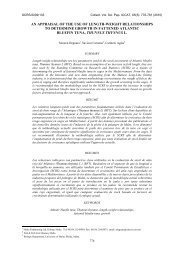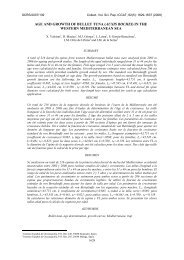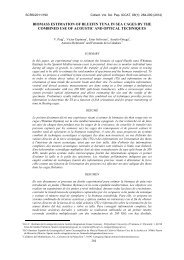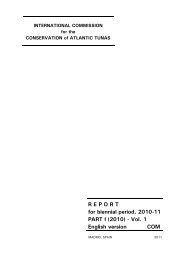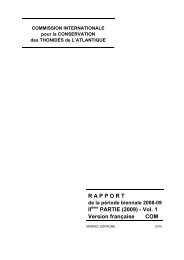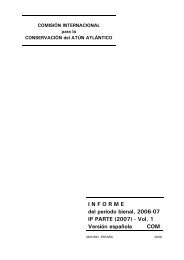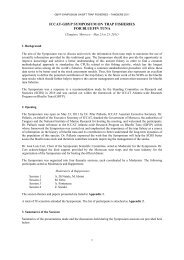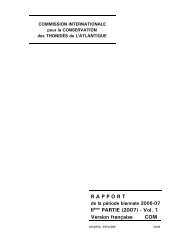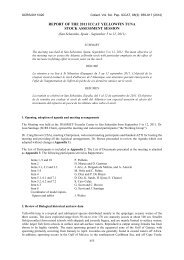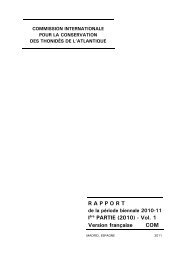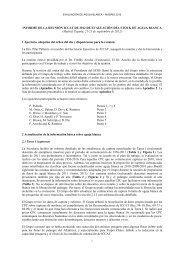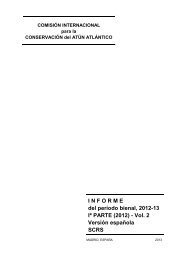E - Iccat
E - Iccat
E - Iccat
You also want an ePaper? Increase the reach of your titles
YUMPU automatically turns print PDFs into web optimized ePapers that Google loves.
ICCAT REPORT 2002-2003 (II)<br />
Without additional catch limit, they will be competing with the existing legitimate licensed vessels . It would<br />
mean punishment of the existing legitimate licensed vessels. For your information, these vessels have<br />
contributed a substantive fund amounting to some US$2 million to support the scrapping program of Japan. We<br />
believe it was not the intention of the international community to penalize those who played the game in a<br />
respectful way, nor was it the intention of the international community to desert a nation who has made its best<br />
effort to cooperate in combating the notorious IUU fishing activities. The resolution adopted by ICCAT that<br />
openly praised and encouraged the joint program was read as a signal of support from ICCAT, at least to ensure<br />
the continued operation of the vessels under the re-registered program.<br />
In fact in our report to the Commission on the joint program of Japan and Chinese Taipei to eliminate IUU largescale<br />
tuna longline vessels (see ICCAT Report 2000-2001 (II), pp. 373), we indicated that owners of some FOC<br />
vessels that operated in the Atlantic Ocean were doubtful about the re-registration program wondering whether<br />
they would be granted any catch allocation after the re-registration, and since they have been fishing all the time<br />
in the Atlantic Ocean, and they would rather prefer not to join the program and continue fishing without any<br />
restriction, if they would eventually be barred from operating in the Atlantic region after the re-registration. For<br />
this reason, from the time these FOC vessels started the re-registration process, the fisheries authority undertook<br />
close monitoring over their catches. When fully implemented, the re-registration program would enable<br />
reduction of FOC/IUU fishing activities, including those in the Atlantic Ocean, bringing the FOC vessels to<br />
proper control under our governance, and thus resulting effective management of resource utilization in the<br />
Atlantic. As such, there was an understanding that those IUU/FOC vessels will still be operating in the<br />
convention area after their re -registration, with additional allocation.<br />
Someone may argue the Commission will be benefiting the ex-IUU/FOC vessels, but we must reconsider the<br />
weight of the benefit of the two sides and see which one receives higher merit, whether it is the management of<br />
fleet under proper control by giving them some allowable catch or it is the thinking of a reputable regional<br />
fisheries management organization like ICCAT to take a harsh and irresponsible action of squeezing them so that<br />
they are forced to leave the Atlantic and have the matter passed to another RFMO.<br />
We are therefore requesting the Commission to provide an additional catch limited of 2,000 t of bigeye and a<br />
reasonable amount of by-catch of southern swordfish. We will certainly continue working closely with all<br />
ICCAT members as well as members of other RFMO in the world in combating IUU fishing activities.<br />
Supplemental Note on Request of Additional Bigeye Catch Limit<br />
To eliminate IUU fishing activities by large-scale tuna longliners in the Atlantic Ocean and other areas, under a<br />
joint action plan with Japan, Chinese Taipei has been doing its best efforts in establishing avenues to permit<br />
those LSTLVs newly built in its shipyards to seek re-registration under its registry. In the course of reregistration,<br />
ICCAT adopted a Resolution entitled the Supplemental Resolution on the Bigeye Statistical<br />
Document Program [Ref. 01-23], in which the importing countries agree to accept a document validated by<br />
Japan or Chinese Taipei on bigeye tuna caught by the vessels participating in the scrapping program by Japan<br />
and those participating in the re-registration program that those vessels shall operate in compliance with the<br />
Commission’s conservation and management measures. There should be an understanding that the issuing of<br />
bigeye statistical documents under this Resolution shall not count against the catch limit to Chinese Taipei.<br />
With the effective of the implementation of the Bigeye Statistical Document as from July 2002, Chinese Taipei<br />
began issuing BETSDs for the vessels seeking re-registration. These vessels were required to install satellite<br />
vessel monitoring system, apply same catch limit per vessel of 183 t as licensed vessels though it was not a<br />
requirement under the said resolution. They were required to submit catch logbooks.<br />
In order to distinguish between these group of vessels and the legitimate licensed vessels, in view of the catch<br />
limitation on bigeye tuna enforced to the legitimate licensed vessels, the catch of these vessels was listed in a<br />
separate column in the Task I figures provided to ICCAT in the national report.<br />
In 2002 the landings of bigeye by the legitimate licensed vessels were 16,503 t and those by the vessels seeking<br />
re-registration were 1,980 t. These figures are consistent with the figures as indicated in Japanese Import of<br />
Frozen Atlantic Bigeye fromChinese Taipei. The Commission may note that such a phenomena will continue in<br />
2003 as the process of re-registration will have to take some time, and by the end of 2003 all these vessels will<br />
have completed their re-registration and that is why the total landings of bigeye tuna by Chinese Taipei will<br />
increase by around 2,000 t. For this reason, Chinese Taipei is requesting the Commission to consider an<br />
additional quota of 2,000 t.<br />
200



